Sitting Bone Pain
On page cat links
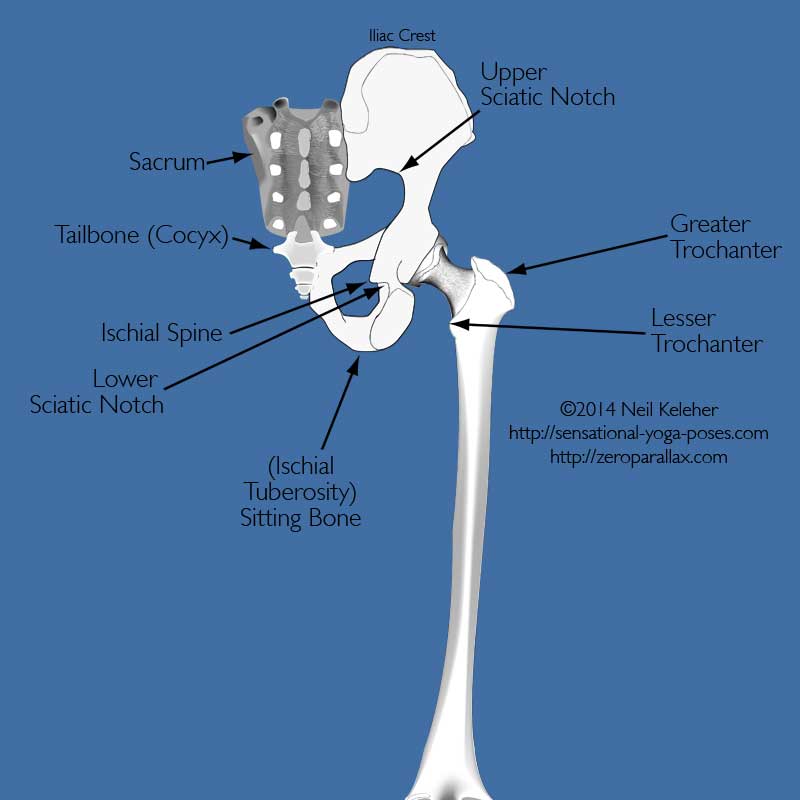
Sitting bone pain isn't so much a bone that aches. Instead it's the muscles that attach to or near the bone that cause sensations of pain.
On page cat links

Sitting bone pain isn't so much a bone that aches. Instead it's the muscles that attach to or near the bone that cause sensations of pain.
The term "Sitting bones" generally refers to the two bones we can feel when we sit on a hard surface. The skeletal anatomy that most closerly relates are the ischial tuberosities. These are the oval shaped surfaces at the back of the bottom of the pelvis.
Muscles that originate near the sitting bone include the gemellus inferior and the quadratus femoris (not pictured below.)
Also important are the obturator internus muscle and the coccygeus.
Sitting bone pain may be because one or more of these muscles is engaged causing excessive tension that we can interprate as pain or discomfort. (Excessive tension in any part of the body can mean that the muscle that is exerting excess tension is compensating for some muscle that isn't working.)
And so just as important as understanding which muscles are over active is understanding which muscles they may be compensating for.
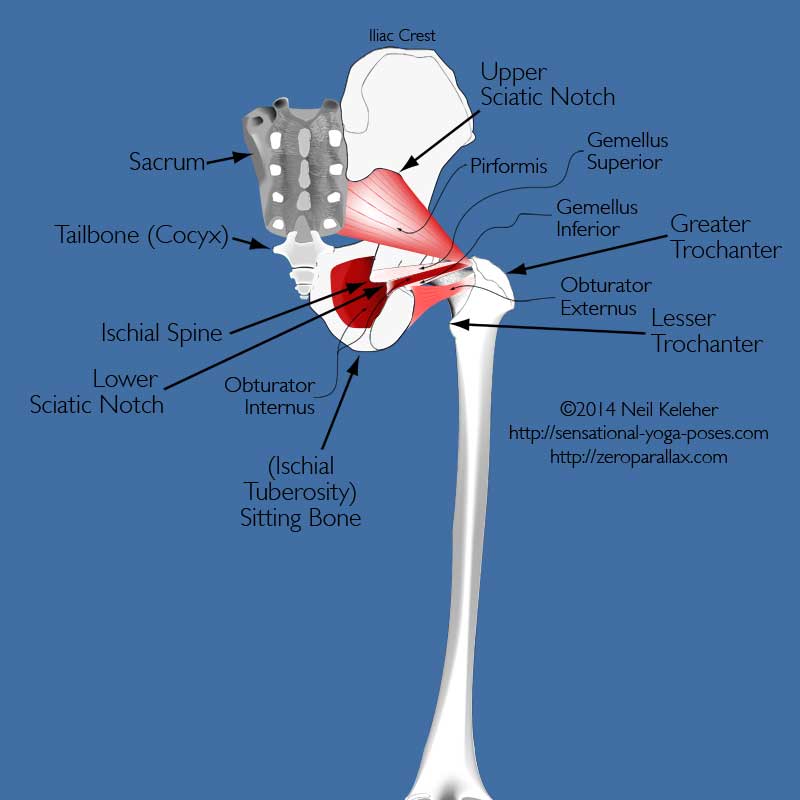
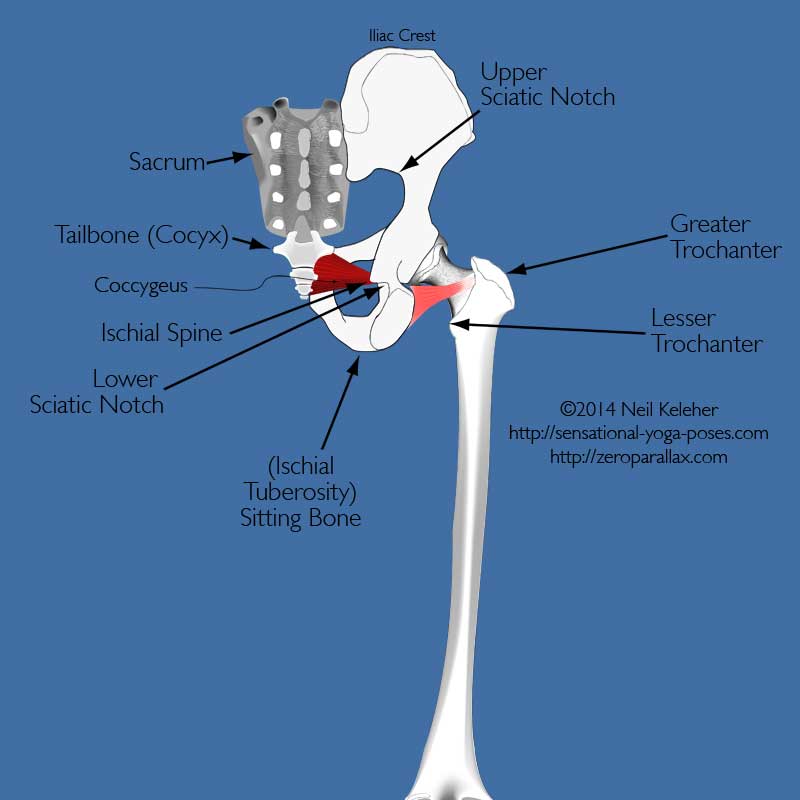
In standing forward bends the muscles that should be doing the work, particularly when the hands aren't being used to support the weight of the upper body, are the gluteus maximus and/or hamstrings.
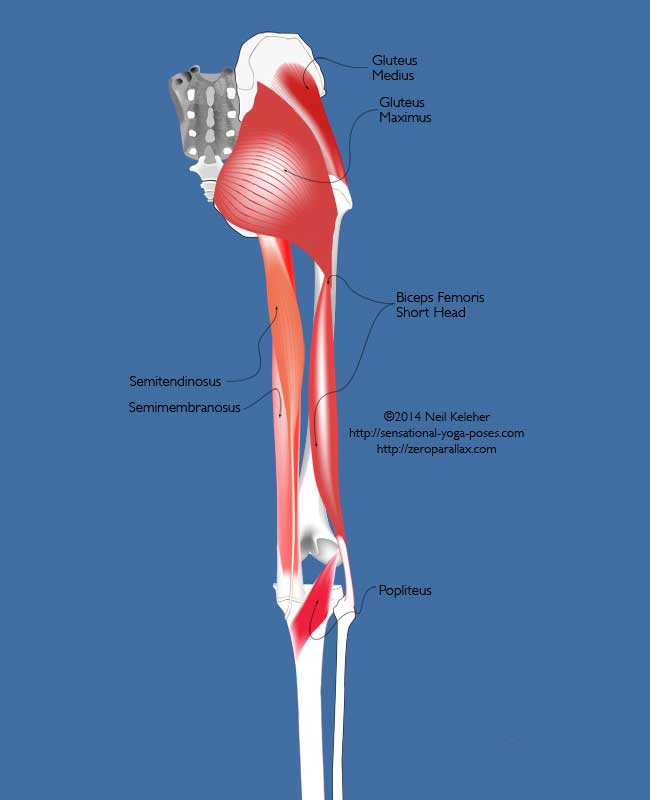
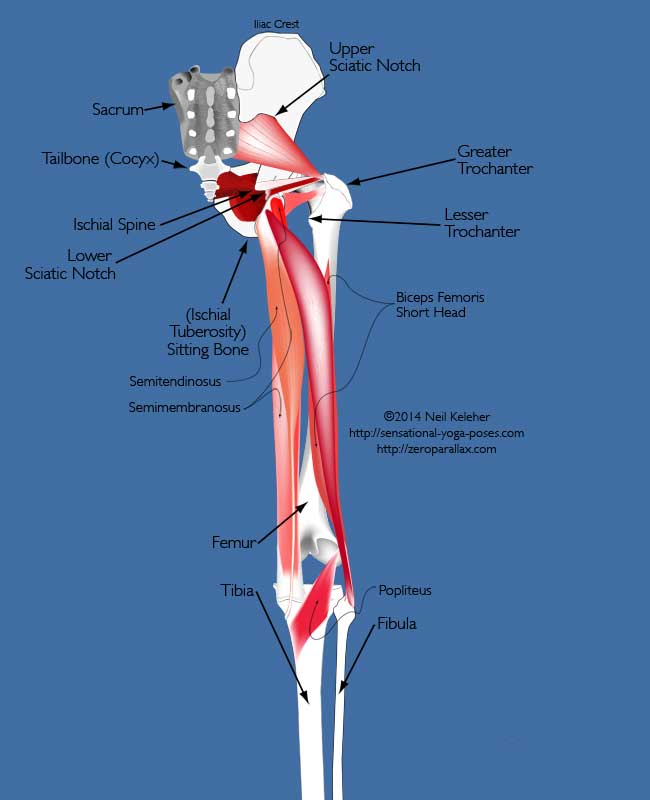
My own experience of sitting bone pain occured while doing asymetric standing forward bends.
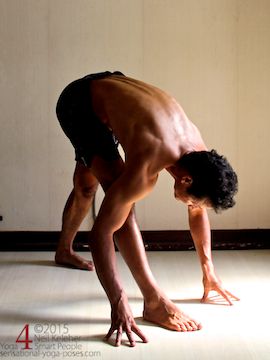
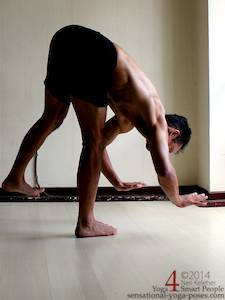
If doing a pose like parsvottanasana (I call this triangle forward bend, it's the same leg position used in reverse prayer but I often do it without the hands in prayer) I often find that when my left leg is forwards my left hip feels week and especially when trying to stand up with the leg straight (without using arms) that's when I get pain in the area of the sitting bone.
Another pose that I have a challenge in is doing a forward bend while balancing on one leg. Here the challenge I had was standing up while staying on one leg.
Note that I didn't experience pain while bending forwards with feet even. It may be that I was able to compensate while standing with both feet even.
In the past I've had a knee injury from a motorcycle accident and I've also bruised my tailbone while sitting down not-too-carefully on the side of the boat.
(Only then did I realize how often the pelvic floor muscles activate. It was a challenge to move in such a way that they didn't activate because when they did I felt in my now overly sensitive tailbone.)
One or the other of these incidents may have caused the problem that resulted in either or both of my obturator internus and coccygeus being facilitated causing sitting bone pain.
I use the words "facilitated" or "over active" as opposed to "too tight" because the problem is possibly that these muscles are activating to compensate for an old injury.
The obturator internus is a muscle that connects to the inner surface of the pelvis.
Its tendon wraps around the back of the pelvis passing around a notch called the lower sciatic notch. (The piriformis, which attaches to the front of the sacrum, passes through the upper sciatic notch.) From there the tendon of the obturator internus angles slightly upwards as well as forwards to attach to a point on the inner surface of the greater trochanter just above the neck of the thigh bone.

The greater trochanter is the knob of bone at the junction of the neck and shaft of the femur. You can feel it/palpatate it at the side of the hip about a hand span below the crest of the hip.
My understanding of the obturator internus is that when active it creates an outward pull on the sitting bones.
Depending on how the leg and pelvis are stabilized it may actually help to deform (or flex) the pelvis, widening the sitting bones and causing the upper front points of the pelvis (the points of bone on either side of the belly just below the height of the belly button).
Initially I thought that perhaps my obturator internus on the left side was over active. I did have a tendency for my left thigh to over rotated making it difficult to press down through the base of the big toe when balancing on one leg or when standing with that leg forwards.
Rather than stretching the obturator, I did a standing meditation and focused on feeling the obturator internus and on relaxing it.
The goal wasn't to keep it relaxed at all times since I believe that it is important in stabilizing the hip, instead it was to stop it from being active all of the time.
I wasn't sure that it was the only problem and so later meditation (and understanding my anatomy, even to a limited extent) led me to believe that the coccygeus was also tight.
The coccygeus is a muscle that connects the tailbone to the ischial spine.

The ischial spine is a protrustion of bone that separates the upper and lower sciatic notches.
This muscle is part of the pelvic floor complex of muscles and I believe it is important in helping to draw the sitting bones inwards and the tail bone forwards.
This action causes the upper front hip points to move apart (which is the opposite to what the obturator internus does). And so it may have been that my obturator was over active because of the coccygeus on the same side or vice versa.
I again used meditation to work on relaxing the coccygeus.
To locate the ischial spine (there are two, one on each side) I focused first on the sitting bone and then from there moved my awareness upwards to about the height of the bottom of the tailbone.
I imagined the ischial spine to be forwards relative to the tailbone.
Focusing on that area I could feel or sense a feeling of "solid" tension, i.e. connective tissue or muscle that was so tight it felt like it was solidified. And I focused on relaxing it.
One of my favorite exercises at the time, in part because I couldn't do it on the one side is bending forwards while standing on one leg.
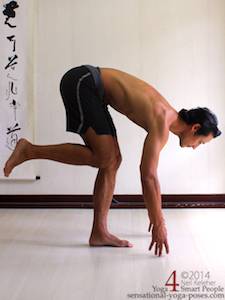
Rather than reaching the other leg back I bend the lifted knee and pull it forwards. This causes the hips to move back relative to the standing foot and makes the hamstrings and glute of the standing leg work harder since the free leg isn't acting as a counter-balance.
Before realizing that I might have had a "stuck" or "facillitated" obturator internus, my focus while doing this pose was to deliberately activate the muscle by spreading the sitting bones.
Initially I did this activation while standing on both legs, then tried it while standing on one leg, then I worked at keeping the action while bending forwards and then (more difficult) while standing back up.
Later I learned to do the same activation while standing on one leg. I keep the pelvis and thigh stationary and create an outward pull on the sitting bone. I notice muscles on the front of the outer hip also activate.
On the bad leg I focused first on relaxing the sitting bone… actually relaxing the obturator internus and coccygeus. Then I drew the sitting bone outwards (re-activating the obturator internus) while trying to keep the coccygeus relaxed.
In general I included this exercise and others as part of my daily routine for a few weeks. I only repeated it a maximum of five times per session, usually only three times. That felt like it was enough. Later on I still had problems with the standing forward bend on one leg but I didn't have the sitting bone pain.
When doing standing forward bends without the hands resting on the floor the hamstrings and the gluteus maximus support the weight of the upper body. They act like anchors or breaks slowing and controlling the forward tilt of the pelvis and via the pelvis the weight of the upper body.


For a while, while doing standing forward bends, my focus was on spreading the sitting bones. This, I believed caused the obturator internus to activate and actually pull the sitting bones apart. This in turn may have added tension to the sacrotuberous ligament. This is a ligament that connects the sacrum to the sitting bones. This could help to stabilize the SI (Sacroiliac) Joint.
Of interest to me is that the gluteus maximus has some fibers that attach to this ligament. My theory at the time is that adding tension to the sacrotuberous ligament (by activating the obturator internus) may actually give these fibers of the gluteus maximus a firm foundation from which to act.
Whether that's the case or not I often find that when spreading the sitting bones my butt muscles activate.
I'd suggest experimenting with this action to see if it helps your sitting bone pain.
Restoring the body can be a lengthy process. It may be helpful to notice the chairs you sit on (and perhaps how you sit or work). As an example I ride a motorcycle daily, and only recently I realized that the seat was a bit of a problem. On the latest trip to the mechanic I looked at the underside of the seat when he took it off to access the electrics, and thus I discovered that the seat was broken on one side. So I had it replaced since it probably wasn't helping my efforts to balance my hips and spine. Earlier I finally got rid of an old office chair that I used frequently since it too was damaged on one side. Did my own imbalances cause these items to fail or was it happenstance? Either way, if you spot things that cause imbalance when you use them you can take action where possible.
Even before I figured out that my motorcycle seat was broken, I also noticed that I tended to sit on one hip while riding. (And in retrospect it is possible that this habit of sitting caused the seat to break on one side.) Noticing that I sat this way I was able to correct it and sit with both sitting bones equally weighted. But then I noticed that when sitting on a hard seat one sitting bone seemed to be more forwards, possibly indicating that one side of my pelvis was rotated forwards with respect to the other side.
And so I began to more widely explore my body.
While it seems like a daunting task I'd suggest that if you focus on little bits at a time, starting with, for example the obturator internus and the coccygeus, you can incrementally learn the body bit by bit. You'll then more likely be able to fix a lot of the problems that arise.
